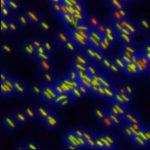Lien vers Pubmed [PMID] – 25543231
Cell Host Microbe 2015 Jan;17(1):32-46
Nonreplicating and metabolically quiescent bacteria are implicated in latent tuberculosis infections and relapses following “sterilizing” chemotherapy. However, evidence linking bacterial dormancy and persistence in vivo is largely inconclusive. Here we measure the single-cell dynamics of Mycobacterium tuberculosis replication and ribosomal activity using quantitative time-lapse microscopy and a reporter of ribosomal RNA gene expression. Single-cell dynamics exhibit heterogeneity under standard growth conditions, which is amplified by stressful conditions such as nutrient limitation, stationary phase, intracellular replication, and growth in mouse lungs. Additionally, the lungs of chronically infected mice harbor a subpopulation of nongrowing but metabolically active bacteria, which are absent in mice lacking interferon-γ, a cytokine essential for antituberculosis immunity. These cryptic bacterial forms are prominent in mice treated with the antituberculosis drug isoniazid, suggesting a role in postchemotherapeutic relapses. Thus, amplification of bacterial phenotypic heterogeneity in response to host immunity and drug pressure may contribute to tuberculosis persistence.

